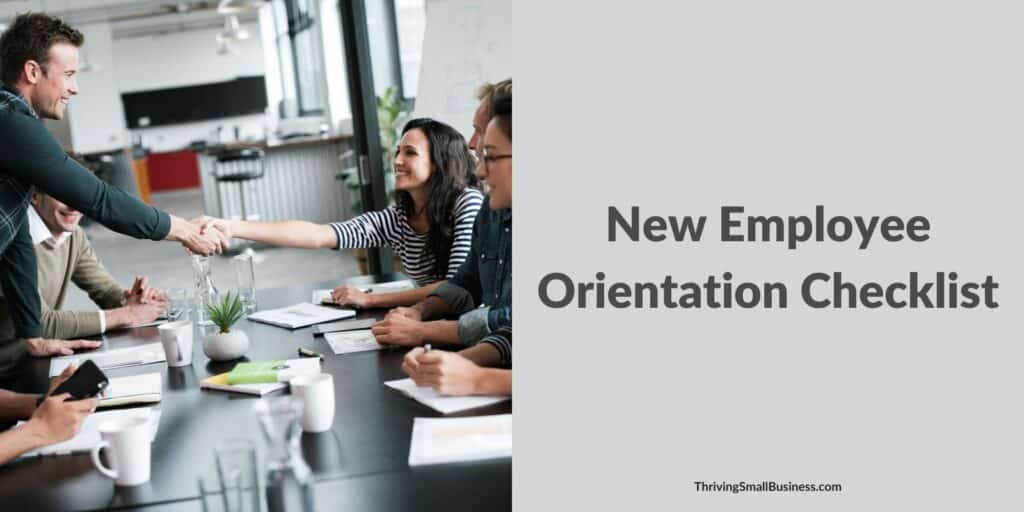Sample New Employee Orientation Checklist
Estimated reading time: 5 minutes
Starting a job means many new things to learn, many people to get to know, and lots of new information that needs to be absorbed quickly.
How an employer welcomes a new employee can set the tone for a successful relationship. Proper onboarding is crucial to this relationship.
They Forgot To Add Me To the Payroll
I remember starting a job for a small organization. It was different from the larger businesses that I had worked for. They had no orientation process.
Consequently, I had worked three weeks and had to ask when payday was. They were on a bimonthly pay system, but the hiring manager forgot to add me to the payroll.
It’s not a very good way to start a job.
Employee Orientation is Important
Onboarding new employees helps them feel like an important addition to the team. But what is the best way to help employees transition from new hire to employee?
Many organizations create a new employee orientation checklist to ensure that all necessary information is communicated during the first few days or weeks on the job.
Every organization is unique and has its own distinct work environment and approach to doing things, so helping new employees acclimate to our way of working benefits both the employee and the organization.

For example, an employee who has worked for a company that allowed the use of social media at work and your organization limits that use to lunch and break times needs to understand these expectations so they don’t inadvertently breach company policy.
A goal for any organization should be to identify everything a new employee needs to know and share that information with them within the first couple of days on the job.
New employees don’t arrive with tacit knowledge. Information we gain from being on the job for a while might seem insignificant, but it can be important for someone new to the organization.
For example, if the cultural norm is to eat lunch in the office lounge, a new employee would want to know how to bring their lunch to work.
Especially, the new hire comes from an organization that encourages employees to leave the office for lunch.
How to Create an Orientation Checklist
Start with the basics.
Gather a team in a room and ask what information was (or would have been) helpful to know when you started your job.
Go around the room, and you might be surprised at the things new hires wish they knew.
For instance, employees may say they wish someone had informed them about the special discount they receive on cell phones.
Or I spoke to someone recently who quit a job he had been at for years and didn’t realize the company had a pension plan.
The information that employees typically know needs to be communicated to new hires so that they can participate in all the benefits of working for the company.
Alternatively, if your business has policies prohibiting moonlighting, a new employee should be aware of them.
The following is a sample of things I’ve shared on a new employee orientation checklist.
Use this example as a starting point to begin thinking about things unique to your environment and modify it accordingly.
Example: New Employee Orientation Checklist
The checklist should be completed and signed within seven days and maintained in the employee file.
| Employee Name: | Hire Date: | Department: |
|---|---|---|
| ☐ Kitchen/Lunchroom | ☐ Voicemail | ☐ Satisfaction Survey |
| ☐ Restrooms | ☐ Customer Feedback | |
| ☐ Supply Storage | ☐ Confidentiality | ☐ Teamwork |
| ☐ Copy Room | ☐ Staff Meetings | ☐ Key Customer Groups |
| ☐ Conference Room | ☐ Meal/Break Times | ☐ Customer Expectations |
| ☐ Office Forms | ☐ Recording Hours | ☐ Difficult Customers |
| ☐ Fitness Center | ☐ Calling In (whom to call) | ☐ Job Description |
| ☐ Postage Machine | ☐ Injury Reports | ☐ Goals |
| ☐ Office Keys | ☐ Assessment | ☐ Performance Appraisal |
| ☐ Office Calendar | ☐ Continuing Education | ☐ Team Expectations |
| ☐ Telephone System | ☐ Dress Code | ☐ Insurance |
| ☐ Office Hours | ☐ Organizational Chart | ☐ Retirement |
| ☐ Alarm System Code | ☐ Computer Passwords | ☐ Paid Time Off |
| ☐ Meet Co-workers | ☐ Assigned Mentor | ☐ Business Cards |
| Employee Signature: | Date: | |
| Supervisor Signature: | Date: |
This is merely a list and can be created into a document (access word checklist template below) that is used as part of the employee record.
Developing a new employee orientation checklist can be the first step toward providing a smooth transition for new employees.
An Orientation Checklist Changes Over Time
A new employee orientation checklist is a work in progress.
Start with the basics and add items as new employees are added, and additional information is identified that needs to be communicated.
As you develop this tool, test it on new employees. After approximately 90 days, follow up with them and ask what information they found helpful to know during their first days and weeks on the job. Then, add those items to the list.
Keep in mind that this is a communication and training tool designed to facilitate a smooth transition for the new employee, ensuring they get off to a strong start and feel supported during their first few weeks on the job.
Taking the time to orient a new employee often translates into fewer issues, and setting expectations during the first few days and weeks on the job can help facilitate a smooth transition.
To access this Word document and customize it for your organization, click here.
How does your organization ensure employees smoothly transition into their new roles?
To learn more about orienting new employees to your organization, you can check out this book, Creative Onboarding Programs: Tools for Energizing Your Orientation Program, available on Amazon.






